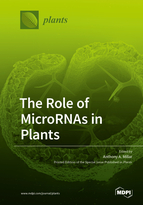The Role of MicroRNAs in Plants
A special issue of Plants (ISSN 2223-7747). This special issue belongs to the section "Plant Molecular Biology".
Deadline for manuscript submissions: closed (10 May 2019) | Viewed by 58960
Special Issue Editor
Special Issue Information
Dear Colleagues,
Discovered at the turn of the century, microRNAs (miRNAs) have been found to be fundamental to many aspects of plant biology. They are predominantly derived from non-coding primary-miRNAs (pri-miRNAs) that are able to form double stranded hairpin structures, which are then processed into mature miRNAs (20-24 nt) via a complex process. These miRNAs are then incorporated into the RNA Induced Silencing Complex (RISC), where the miRNA guides RISC to (m)RNAs of high sequence complementarity. The RISC then represses the expression of these target mRNAs via a complex mechanism that includes RNA degradation and translational inhibition. Consistent with their importance, there is a core set of conserved miRNA that are ancient, being present throughout land plants, controlling processes such as phase change, organ polarity, leaf and root development, flowering and responses to environmental stimuli. The mRNA targets of these ancient miRNAs are mainly regulatory genes such as transcription factors, explaining why these miRNAs act as master regulators of gene expression and phenotypic outcomes.
Despite this wealth of knowledge, there are still many unanswered questions regarding miRNA biology. Our understanding of miRNA biogenesis is still incomplete; how a mature miRNA is precisely processed from a pri-miRNA is far from resolved. Regarding the actual silencing process, the mechanism of translational repression remains largely elusive, as does the extent it plays in silencing. Our understanding of target recognition is far from perfect, of the many bioinformatically predicted targets, only a few of these ever appear to be functionally significant targets. Beyond the conserved set of miRNAs, deep sequencing of small RNAs from many different plant species has identify a myriad of less conserved miRNAs, that correspond to immense regulatory potential. However, for the majority of these miRNAs, there is little functional evidence regarding the (m)RNAs they target, and the role, if any, they play in the plant. Finally, the extent to which miRNAs move between cells, tissues, plants and kingdoms to regulate genes in trans, is an area of great interest, but with still many unknowns. This Special Issues of Plants aims to touch on some of these issues.
Dr. Anthony A Millar
Guest Editor
Manuscript Submission Information
Manuscripts should be submitted online at www.mdpi.com by registering and logging in to this website. Once you are registered, click here to go to the submission form. Manuscripts can be submitted until the deadline. All submissions that pass pre-check are peer-reviewed. Accepted papers will be published continuously in the journal (as soon as accepted) and will be listed together on the special issue website. Research articles, review articles as well as short communications are invited. For planned papers, a title and short abstract (about 100 words) can be sent to the Editorial Office for announcement on this website.
Submitted manuscripts should not have been published previously, nor be under consideration for publication elsewhere (except conference proceedings papers). All manuscripts are thoroughly refereed through a single-blind peer-review process. A guide for authors and other relevant information for submission of manuscripts is available on the Instructions for Authors page. Plants is an international peer-reviewed open access semimonthly journal published by MDPI.
Please visit the Instructions for Authors page before submitting a manuscript. The Article Processing Charge (APC) for publication in this open access journal is 2700 CHF (Swiss Francs). Submitted papers should be well formatted and use good English. Authors may use MDPI's English editing service prior to publication or during author revisions.
Keywords
- miRNAs
- miRNA biogenesis
- silencing mechanism
- miRNA target recognition
- bioinformatics for miRNA identification and target prediction
- functional analysis
- developmental and stress responsive miRNAs







